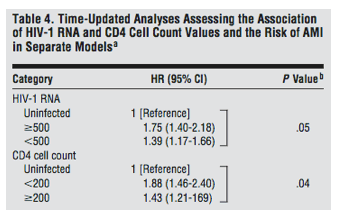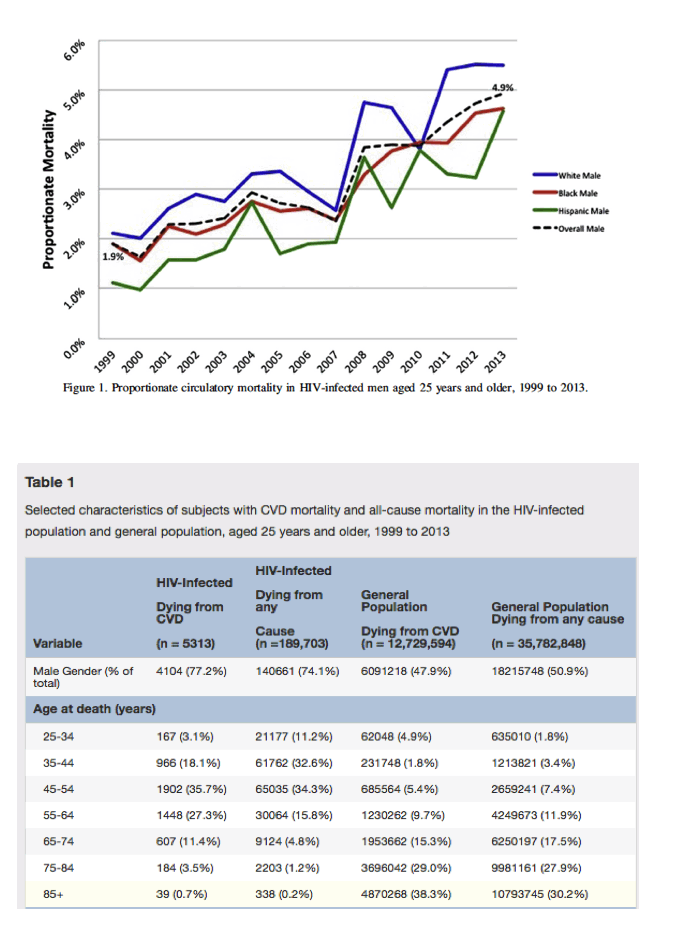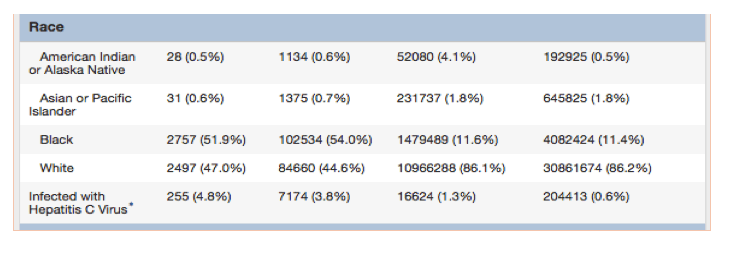| |
HIV-Increased Stroke Rates/50% Higher
|
| |
| |
Download the PDF here
Our data demonstrate overall stroke rates of 5.27 per 1000 person-years in HIV-infected versus 3.75 in non-HIV-infected patients, for a HR of 1.40 http://www.natap.org/2012/HIV/070912_08.htm......After controlling for traditional stroke risk factors, HIV remained an independent predictor of stroke (HR: 1.21.....Unadjusted age-stratified incidence rates and incidence rate ratios demonstrate that HIV infection was associated with higher rates of stroke among those younger than 50, but not among older patients (Fig. 1). This effect was more pronounced in women, where it was seen for each age stratum younger than 50, than in men where only those HIV patients age 30-39 years had elevated stroke rates.......Inflammation underlies the pathogenesis, progression, and complications of atherosclerosis.25 HIV itself, independent of ART use, has been shown to induce endothelial dysfunction, an early marker of atherosclerosis,26,27 and multiple studies have demonstrated increased levels of inflammatory markers in HIV-infected patients.28 Moreover, an immune-mediated prothrombotic state with elevated d-dimer,29 tissue plasminogen activator antigen, and plasminogen-activator inhibitor-1, markers of impaired fibrinolysis associated with risk of CHD, may also confer stroke risk.30,31 Macrophage activation, seen even among those with well-controlled infection and recently associated with noncalcified plaque, may also play a role in the premature development of atherosclerosis.32......The proportion of HIV-infected patients with traditional stroke risk factors including hypertension, diabetes mellitus, dyslipidemia, smoking, cardiomyopathy, left-sided valvular heart disease, and heart failure was significantly higher than in the non-HIV cohort.......In a separate sensitivity analysis, statin use was associated with decreased stroke risk when included in the overall model (HR: 0.77, 95% CI: 0.65 to 0.93, P = 0.005) and in the HIV-only model (HR: 0.43, 95% CI: 0.18 to 1.03, P = 0.059)......In addition to HIV status, other significant predictors of ischemic stroke in the overall group included age, hypertension, smoking, structural heart disease, and atrial fibrillation (Table 3). Dyslipidemia was associated with a decreased risk of stroke.
-------------------------
"Cardiovascular disease (CVD) is the most common cause of mortality among adults in the United States3 and occurs earlier and more commonly in HIV-infected subjects, who have an estimated 50% greater risk for myocardial infarction (MI) compared with uninfected subjects and an estimated 4.5-fold greater risk for sudden cardiac death......http://www.natap.org/2013/HIV/031113_01.htm : Framingham risk factors, hepatitis C virus infection, renal disease, and anemia were independently associated with AMI (Table 3).
Results:
We analyzed data on 82 459 participants. During a median follow-up of 5.9 years, there were 871 AMI events. Across 3 decades of age, the mean (95% CI) AMI events per 1000 person-years was consistently and significantly higher for HIV-positive compared with uninfected veterans: for those aged 40 to 49 years, 2.0 (1.6-2.4) vs 1.5 (1.3-1.7); for those aged 50 to 59 years, 3.9 (3.3-4.5) vs 2.2 (1.9-2.5); and for those aged 60 to 69 years, 5.0 (3.8-6.7) vs 3.3 (2.6-4.2) (P<.05 for all). After adjusting for Framingham risk factors, comorbidities, and substance use, HIV-positive veterans had an increased risk of incident AMI compared with uninfected veterans (hazard ratio, 1.48; 95% CI, 1.27-1.72). An ex- cess risk remained among those achieving an HIV-1 RNA level less than 500 copies/mL compared with uninfected veterans in time-updated analyses (hazard ratio, 1.39; 95% CI, 1.17-1.66).

Although traditional CVD risk factors are common in the HIV-infected population, this increased risk for CVD is independent of traditional risk factors and related to a complex interplay of chronic inflammation and side effects of ART, particularly protease inhibitors.10, 11, 12, 13Despite this elevated risk for CVD, HIV-infected patients receiving care for acute MI are significantly less likely than uninfected patients to receive standard of care procedures for acute MI, such as coronary angiography.14"
"In this study, we used a national US database of mortality data and found that the proportion of deaths related to CVD increased more than twofold in HIV-infected subjects between 1999 and 2013. This pattern was particularly apparent in men and contrasts sharply against the decrease in proportionate CVD-related mortality for the general US population and patients with inflammatory polyarthropathies during the same period. The increase in proportionate CVD mortality in HIV-infected persons is not surprising given their decreasing competing risks for AIDS-related mortality in recent years, their elevated risks for CVD, and the overall aging of the US. HIV population.
The results of this study underscore the emerging need for enhanced CVD risk prediction and prevention in the HIV-infected population."
--------------------------
Patterns of Cardiovascular Mortality for HIV-Infected Adults in the United States: 1999 to 2013
LOOK AT RATES FOR BLACKS in Table 1 below
Compared with the general population, HIV-infected subjects dying from CVD were more likely to be men, black, younger, urban-dwelling, and to have died in a medical facility. Among HIV-infected persons dying from any cause, those dying from CVD tended to be older.
For the overall HIV-infected population, CVD mortality increased from 1999 to 2013 but total mortality decreased; proportionate CVD mortality increased from 1.95% in 1999 to 4.62% in 2013
Although proportionate CVD mortality increased more than twofold for HIV-infected persons, proportionate CVD mortality decreased in the general and inflammatory polyarthropathy populations during the same period.
In another sensitivity analysis assessing CVD subtypes, proportionate mortality due to ischemic heart disease (mortality due to ischemic heart disease/overall mortality) increased threefold in the HIV-infected population, from 0.8% in 1999 to 2.5% in 2013 but decreased in the general population, from 22.8% in 1999 to 14.6% in 2013


Discussion
In this study, we used a national US database of mortality data and found that the proportion of deaths related to CVD increased more than twofold in HIV-infected subjects between 1999 and 2013. This pattern was particularly apparent in men and contrasts sharply against the decrease in proportionate CVD-related mortality for the general US population and patients with inflammatory polyarthropathies during the same period. The increase in proportionate CVD mortality in HIV-infected persons is not surprising given their decreasing competing risks for AIDS-related mortality in recent years, their elevated risks for CVD, and the overall aging of the US. HIV population.
The results of this study underscore the emerging need for enhanced CVD risk prediction and prevention in the HIV-infected population. Traditional coronary heart disease risk prediction models, such as the Framingham Risk Score, may provide inadequate discrimination and be poorly calibrated in the HIV-infected population in light of the elevated HIV-related MI risks that may differ from traditional risk factors.25, 26 Age and demographic disparities between the general population and HIV-infected population may also limit the applicability of traditional cardiovascular risk prediction models in the HIV-infected population. Accordingly, studies evaluating newer atherosclerotic CVD (ASCVD) risk prediction models (such as the American College of Cardiology/American Heart Association ASCVD risk estimator) with potential incorporation of HIV-specific variables are warranted.
To improve the cardiovascular health of the HIV-infected population, more large-scale randomized data on preventive cardiovascular interventions are needed. Although a number of small, randomized statin trials in the HIV-infected population have demonstrated significant improvements in lipids and subclinical CVD, there is a dearth of trial data assessing hard clinical end points.27TheRandomized Trial to Prevent Vascular Events in HIV (REPRIEVE: AIDS Clinical Trials Group study A5332) has recently been initiated and represents the first large-scale randomized clinical trial testing a pharmacologic strategy (pitavastatin) for heart disease prevention in the HIV-infected population.
A number of limitations of this study must be acknowledged. Because death certificates were our sole source of data for this population-level analysis, our ability to assess disease-specific variables was limited, and we could not validate ICD10-coded diagnoses with expert chart review or other methods for adjudication. However, previous studies of large administrative databases have demonstrated ample agreement between individual-level ICD10 diagnoses assigned by providers in routine clinical care and the relative “gold standard” of diagnoses determined by blinded expert chart reviewers and/or auditors.28, 29 We performed sensitivity analysis that included only in-hospital deaths due to concerns regarding systematic differences in ICD10-coded causes of death on in-hospital versus out-of-hospital deaths and still found a substantial increase in proportionate CVD mortality for the HIV-infected population and a decrease for the general population from 1999 to 2013.
It is also possible that there were systematic differences between the HIV-infected and general populations in how causes of death were classified. For instance, if an underlying cause of death was unclear for 2 subjects, it is possible that the HIV-infected individual's death was attributed to the most common cause in the HIV-infected population, AIDS-related illness, whereas the uninfected individual's death was attributed to CVD, the most common cause of death in the general adult population. If this were the case, it would have led to systematic underreporting of CVD deaths and resulting underestimation of the burden of CVD-related mortality in the HIV-infected population. Furthermore, it is possible that this theoretical underreporting of CVD deaths in the HIV-infected population could have changed from 1999 to 2013 with increased recognition of CVD risk in HIV, thus, partially contributing to the temporal increase in proportionate CVD mortality in the HIV population observed in this study. Another factor limiting our ability to compare HIV and general populations is the unique and significant aging of the HIV population from 1999 to 2013. Although this may account for some of the increase in CVD mortality in HIV-infected subjects during this period, the mean age of HIV-infected subjects dying from any cause also increased from 1999 to 2013, thus limiting the degree to which aging alone would impact proportionate mortality. Despite these limitations, the population-wide and 15-year scope of this study provides sufficient and varied hard clinical end points to evaluate temporal and demographic patterns to an extent not entirely replicable by longitudinal cohort studies. Furthermore, we believe that the population-level nature of this study, derived from the entire US population aged 25 years or older at the time of death from 1999 to 2013, represents a substantial and complementary addition to existing HIV mortality literature.
|
|
| |
| |
|
|
|